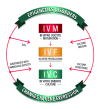Epigenetic disorders and altered gene expression after use of Assisted Reproductive Technologies in domestic cattle
- PMID: 24709985
- PMCID: PMC4065177
- DOI: 10.4161/epi.28711
Epigenetic disorders and altered gene expression after use of Assisted Reproductive Technologies in domestic cattle
Abstract
The use of Assisted Reproductive Technologies (ARTs) in modern cattle breeding is an important tool for improving the production of dairy and beef cattle. A frequently employed ART in the cattle industry is in vitro production of embryos. However, bovine in vitro produced embryos differ greatly from their in vivo produced counterparts in many facets, including developmental competence. The lower developmental capacity of these embryos could be due to the stress to which the gametes and/or embryos are exposed during in vitro embryo production, specifically ovarian hormonal stimulation, follicular aspiration, oocyte in vitro maturation in hormone supplemented medium, sperm handling, gamete cryopreservation, and culture of embryos. The negative effects of some ARTs on embryo development could, at least partially, be explained by disruption of the physiological epigenetic profile of the gametes and/or embryos. Here, we review the current literature with regard to the putative link between ARTs used in bovine reproduction and epigenetic disorders and changes in the expression profile of embryonic genes. Information on the relationship between reproductive biotechnologies and epigenetic disorders and aberrant gene expression in bovine embryos is limited and novel approaches are needed to explore ways in which ARTs can be improved to avoid epigenetic disorders.
Keywords: DNA methylation; embryo culture; genome imprinting; in vitro maturation; superovulation.
Figures





References
Publication types
MeSH terms
LinkOut - more resources
Full Text Sources
Other Literature Sources
Medical
